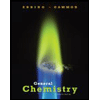
Mercury in the environment can exist in oxidation states 0, +1, and +2. One major question in environmental chemistry research is how to best measure the oxidation state of mercury in natural systems; this is made more complicated by the fact that mercury can be reduced or oxidized on surfaces differently than it would be if it were free in solution. XPS, X-ray photoelectron spectroscopy, is a technique related to PES (see Exercise 7.111 ), but instead of using ultraviolet light to eject valence electrons, X rays are used to eject core electrons. The energies of the coreelectrons are different for different oxidation states of the element. In one set of experiments, researchers examined mercury contamination of minerals in water. They measured the XPS signals that corresponded to electrons ejected from mercury's 4f orbitals at 105 eV, from an X-ray source that provided 1253.6 eV of energy (1 ev = 1.602 x 10 19J). The oxygen on the mineral surface gave emitted electron energies at 531 eV, corresponding to the 1s orbital of oxygen. Overall the researchers concluded that oxidation states were +2 for Hg and -2 for 0. (a) Calculate the wavelength of the X rays used in this experiment. (b) Compare the energies of the 4f electrons in mercury and the 1s electrons in oxygen from these data to the first ionization energies of mercury and oxygen from the data in this chapter. (c) Write out the ground-state electron configurations for He2+ and 02- ; which electrons are the valence electrons in each case?
Want to see the full answer?
Check out a sample textbook solution
Chapter 7 Solutions
LAB EXPERIMENTS FOR CHEM >C<
- 18. A 10.2g piece of coal (carbon) is combusted completely beneath a calorimeter containing 800.0 mL of water. The initial temp of the water was 20.0°C, and the final temp was 62.7°C. Assuming complete transfer of heat from the carbon to the water, what is the molar enthalpy of combustion of carbon?arrow_forwardpls help asap on all.arrow_forwardpls help asap on all.arrow_forward
- Use the reaction coordinate graph below to answer questions 13-15: 13. Which step is the rate determining step? a. C→ E b. E→ G C. A → C d. Not enough information 14. The overall reaction: a. is exothermic b. is endothermic C. has no change in energy Energy d. not enough information 15. The activation energy for the overall reaction would be equal to: a. Ꭰ A b. F C. B d. B + D + F B 0 D E Reaction coordinate Garrow_forwardpls help asap on all.arrow_forwardpls help asap on all.arrow_forward
- 3. Which of the following best describes the changes in reaction rate for the reactants as a reaction progresses? a. Reaction rate remains relatively constant for the duration of the reaction b. Reaction rate is highest at the beginning, and decreases over time C. Reaction rate is highest at the beginning and end of a reaction d. Reaction rate is slow at first, then increases 4. Which of these would be the closest to being an isolated system? a. A well-insulated steel thermos b. Earth C. A sealed plastic container d. All of the above are examples 5. A chemical engineer is performing a test to see if a proposed catalyst for an industrial chemical reaction is working effectively. Which of the following would be positive evidence that it's working? a. The enthalpy of the reaction increases b. Less heat is required to get the reaction started C. The reaction creates new products d. The enthalpy of the reaction decreasesarrow_forwardPls help me on this q.arrow_forwardGiven the elementary reactions in an aqueous medium with an ionic strength of 0.001:1) CH3Br + OH- → CH3OH + Br-2) ClCH2COO- + OH- → HOCH2COO- + Cl-3) [Co(NH3)5Br]2+ + NO2- →[Co(NH3)5NO2]2+ + Br-If the ionic strength is decreased, 1) k will not change; 2) k will decrease; and 3) k will increase. Is this correct?arrow_forward
- Relate zero ionic strength and infinite dilution limit.arrow_forwardThe photolysis of H3C–N=N–C2H5 involves the breaking of the single bonds shown. According to this, in addition to N2, what products would be obtained primarily if the reaction were carried out in the gas phase or in solution in an inert solvent?arrow_forwardGiven a keto-enol tautomerization reaction, which is greatly influenced by the type of solvent, indicate which of the following solvent properties cannot be considered a "solvent effect"?(A) Dielectric constant(B) Polarity(C) Hydrogen bonding capacity(D) Temperaturearrow_forward
 Introductory Chemistry: A FoundationChemistryISBN:9781337399425Author:Steven S. Zumdahl, Donald J. DeCostePublisher:Cengage Learning
Introductory Chemistry: A FoundationChemistryISBN:9781337399425Author:Steven S. Zumdahl, Donald J. DeCostePublisher:Cengage Learning Chemistry: The Molecular ScienceChemistryISBN:9781285199047Author:John W. Moore, Conrad L. StanitskiPublisher:Cengage Learning
Chemistry: The Molecular ScienceChemistryISBN:9781285199047Author:John W. Moore, Conrad L. StanitskiPublisher:Cengage Learning
 Chemistry for Engineering StudentsChemistryISBN:9781337398909Author:Lawrence S. Brown, Tom HolmePublisher:Cengage Learning
Chemistry for Engineering StudentsChemistryISBN:9781337398909Author:Lawrence S. Brown, Tom HolmePublisher:Cengage Learning General Chemistry - Standalone book (MindTap Cour...ChemistryISBN:9781305580343Author:Steven D. Gammon, Ebbing, Darrell Ebbing, Steven D., Darrell; Gammon, Darrell Ebbing; Steven D. Gammon, Darrell D.; Gammon, Ebbing; Steven D. Gammon; DarrellPublisher:Cengage Learning
General Chemistry - Standalone book (MindTap Cour...ChemistryISBN:9781305580343Author:Steven D. Gammon, Ebbing, Darrell Ebbing, Steven D., Darrell; Gammon, Darrell Ebbing; Steven D. Gammon, Darrell D.; Gammon, Ebbing; Steven D. Gammon; DarrellPublisher:Cengage Learning ChemistryChemistryISBN:9781305957404Author:Steven S. Zumdahl, Susan A. Zumdahl, Donald J. DeCostePublisher:Cengage Learning
ChemistryChemistryISBN:9781305957404Author:Steven S. Zumdahl, Susan A. Zumdahl, Donald J. DeCostePublisher:Cengage Learning





